Part two: Chasing down Sunny, World Cup glory and a century of centuries
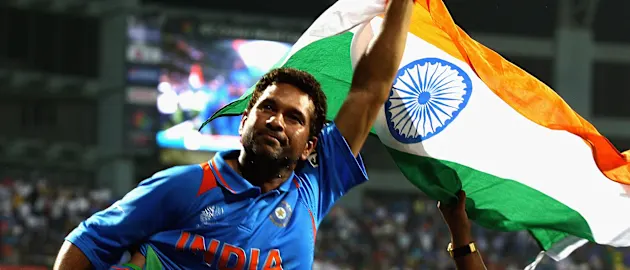

In part two of this career retrospective, we look back on his injury troubles in the mid-2000s to a new lease on life that saw him achieve every dream imaginable.
CHASING DOWN SUNNY
While he had dominated the World Cup, 2003 was a lean year for Tendulkar in Test cricket. He averaged 17 across his five matches and for the first time in his career was underperforming.
He was back to his best in the format in the early parts of 2004, starting the year with an unbeaten 241 at the SCG. Across his first three innings of the year he scored 495 runs without being dismissed, and had moved within one century of equalling Sunil Gavaskar’s record of 34 Test tons.
However, the tolls of a decade-and-a-half of international cricket had started to show. In August that year, he was diagnosed with tennis elbow in his left arm, ruling him out of the Champions Trophy and sidelining him for the first two Tests of Australia’s tour of India in October.
With the help of painkillers he was able to return for the third and fourth Tests of the series and in December against Bangladesh, he finally drew level with Gavaskar, hitting an unbeaten 248.
As a teenager, he had been gifted a pair of pads by Gavaskar and on the occasion of his 34th Test century, the original ‘Little Master’ sent Tendulkar 34 bottles of champagne.
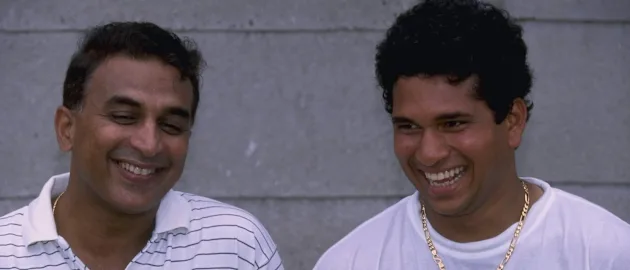
It took almost a year to the day for Tendulkar to raise century No.35. In March 2005 he went close, scoring 94 against Pakistan at Mohali. But by the end of that series, it became clear more drastic action needed to be taken to resolve the elbow injury. In May, Tendulkar had surgery on the troublesome joint and in October he finally returned to international cricket.
At 4:44pm on 10 December 2005, Sachin Tendulkar clipped Chaminda Vaas off his pads through square leg at the Feroz Shah Kotla and scurried through for a history-making single. With it he raised the 35th Test century of his career, going past hero and mentor Gavaskar.
Known to be an understated celebrator, Tendulkar revelled in the moment when he broke the record. There was a shout of jubilation before he looked to the heavens in honour of his father, before saluting the dressing room. "This was a very important hundred for me, four-and-a-half months after elbow surgery,” he said.
“Mentally it [the break because of injury] was very tough on me but physically I could cope. I got frustrated and impatient, so getting out of it was not a singular effort – my family, physio, trainer ... they all helped.”
Asked what was to come next: "I can't say what heights I am going to achieve. But what you can expect from me, what is in my hands, is 100% commitment and sincerity and playing for the cause of the team."
But first, there would be another visit to the surgeon to remedy a cyst pressing on a nerve in his right shoulder.
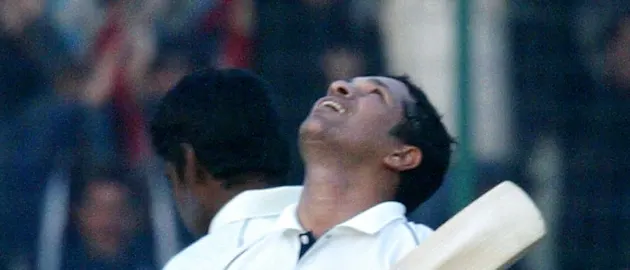
RETURN TO FORM
With the record for the most Test centuries in the bag, Tendulkar’s next aim was to fulfil the lifelong dream of winning the Cricket World Cup at the 2007 edition. Unfortunately for India, the tournament could not have gone much worse as they failed to make the knockout stages.
Having spent much of the past two years fighting injury, an underwhelming World Cup for India left the great man considering retirement. A phone call from the legendary Sir Vivian Richards put those thoughts to bed, and in 2008, the form that had made Tendulkar a world conqueror started to return.
He started the year with an unbeaten 154 against Australia in the New Year’s Test at the SCG, backed it up with an important 71 as India enjoyed a victory to remember at the WACA, and rounded out his series with a 153 in the fourth Test. His series haul of 493 at 70.42 is the most runs he ever managed in a single campaign.
He carried that form into the ODI tri-series, in which he was the star of the best-of-three final, scoring an unbeaten 117 in the first final and 91 in the second as India won the tournament.

2008 saw him notch 1000 Test runs in a calendar year for the first time since 2002 and fittingly it was the year in which he became the format’s greatest ever run-scorer. Having overcome a sports hernia in the middle of the year, Tendulkar eclipsed Brian Lara and became the first batter to ever score 12,000 Test runs during a fluent 88 against Australia in Mohali. The moment was met by a fireworks display that lasted close to three minutes.
In a career littered with magical moments, he produced one of his most significant in December 2008. With the nation reeling in the aftermath of the Mumbai terror attacks, the city’s favourite son stepped up in India’s next Test, scoring an unbeaten 103 to help chase down a target of 387 against England in Chennai.
Asked whether this century mattered more than any of his others, Tendulkar replied: "Yes, especially after what happened in Mumbai. By no means am I saying this will make everyone forget what happened in Mumbai but I'd like to thank England for coming back and playing Test cricket and we've witnessed a wonderful Test match — people are enjoying cricket the way it's meant to be.
"What happened in Mumbai was extremely unfortunate and I don't think by India winning or me scoring a hundred, people who have lost their loved ones will feel any better. It's a terrible loss for all of them and our hearts are with them, but whatever manner we can contribute to making them feel better we'll make that effort."
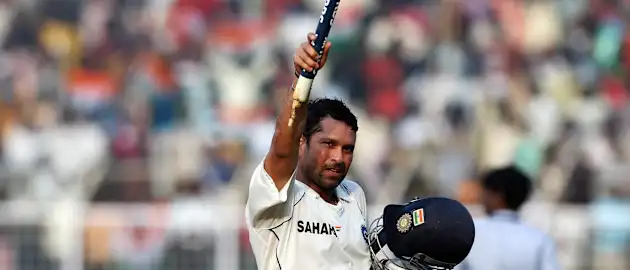
THE GOLDEN YEAR
In 2010, in the fourth decade of his career, Tendulkar enjoyed his greatest ever year in Test cricket. In his 21st year as an international cricketer, the 37-year-old helped himself to 1562 runs at 78.10, scoring seven centuries and five half-centuries across 14 Tests.
In what proved a fruitful year for India, he was their highest run-scorer, notching his 50th Test century as the team solidified their spot at the top of the Test rankings.
He only played two ODIs in 2010 but he made them count. In the first, against South Africa at Jaipur, he was run out for four. In the second, against the same team at Gwalior, he became the first batter to score a double-century in a men’s ODI.
Against an attack spearheaded by Dale Steyn, he batted the entirety of the innings, making an unbeaten 200 off 147 balls, hitting 25 fours and three sixes, reaching the milestone in the very last over of the match.
Five other batsmen have achieved the feat in men’s ODIs since but there simply could be no one else but Tendulkar to break that barrier in men’s cricket.
"Nobody else does deserve to get there,” Saeed Anwar, who shared the record for the highest men’s ODI score of 194 with Charles Coventry, said in 2010. “It's only Sachin who deserves to scale that peak. Two-hundred is a big score in one-day cricket. It's not easy to get there. It took him 20 long years to get there. He has come a long way. It's Sachin's greatness.”
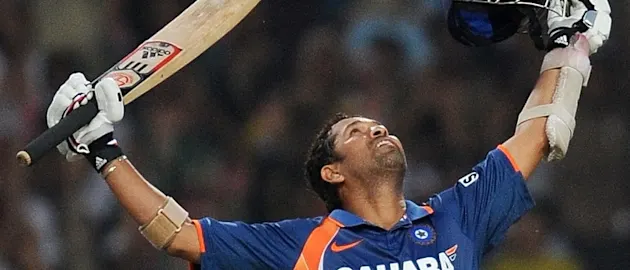
2011 WORLD CUP
In 2011, Tendulkar’s long quest to get his hands on a World Cup trophy finally came to an end.
He was a child inspired when India won it for the first time in 1983 and a ball boy when the nation hosted it in 1987. He was a rookie in 1992 and the highest run-scorer in the 1996 and 2003 editions, with quieter performances on either side of a runners up finish in the latter.
In 2011 there would be no denying him. Part of a power-packed Indian batting order, he scored two tons in the pool stage of the tournament, with the 101-ball 111 he made against South Africa the last of his record six World Cup centuries.
CWC11: Sachin Tendulkar's 120 v England
He then stepped up in both the quarter-final and semi-final, scoring an important 53 against Australia before a Player of the Match performance against Pakistan to guide India through to the final at his home ground of the Wankhede Stadium, Mumbai.
He fell for 18 in the decider but had well and truly earned his winner’s medal, finishing as the tournament’s second-highest run-scorer with 482 at 53.55.
Heir apparent Virat Kohli summed up the moment perfectly after Tendulkar was carried around the stadium by teammates who had grown up idolising him.
“Tendulkar has carried the burden of the nation for 21 years,” Kohli said. “It was time we carried him."
CWC11: Tendulkar steps up with vital half-century in semi-final
THE 100th HUNDRED
Tendulkar finished the 2011 World Cup with 99 international centuries to his name. The march to the 100th was longer and more arduous than he would have liked, but on 16 March 2012, he got to celebrate the moment against Bangladesh at Dhaka.
In the year since his 99th, he had come agonisingly close to the 100th time and time again. At the Oval, in the country where he had scored his first international century, he fell for 91 in August 2011. In November against the West Indies at his home ground, he fell for 94. Against Australia at the SCG, his favourite ground outside of India, he was dismissed for 80.
But it was always a matter of when not if.
More than 20 years separated Tendulkar’s first and last international centuries. They came across 13 different countries, five different continents, three decades and against nine different opponents.
"What stands out in an exceptional career of unbelievable achievements is Sachin Tendulkar's ability to change, adapt and mould his batting according to the conditions around him,” Dravid summated after the milestone. “What makes him a phenomenal player is that he has done so many things, be it scoring the highest number of Test and one-day runs or scoring a century of international centuries.
“What he has done is set a benchmark for future generations which, probably, would be almost impossible for anyone to emulate. He has created a new milestone, which to my mind, is like Don Bradman's average of 99.94, the most memorable feat that any cricketer has achieved."
ICC Hall of Fame: Sachin Tendulkar
FAREWELLING INTERNATIONAL CRICKET
On November 16, 2013, Tendulkar played his final day of international cricket, bowing out of the game after his 200th Test match at Wankhede Stadium.
There were glimpses of the Sachin of yore in his final innings. A drive against the turning ball through mid-off for four, powerful cut shots and delicate clips down the leg side. And, of course, a couple of trademark checked drives to long-off for four – the shot that always meant he was seeing them well.
He went past 50 in 91 balls and it seemed written in the stars he would finish his career with one last century. Don Bradman could not finish his career with a perfect 100 in the record books, maybe Sachin couldn’t either. A hundred hundreds was simply too round a number after all.
Alas, it was not to be. The useful off-spin of Narsingh Deonarine drew an attempted cut shot but there was just a fraction too much bounce. It took the edge and Darren Sammy took a sharp catch at first slip.
An eery silence momentarily descended on the Wankhede before a standing ovation erupted to carry him off the field.
At the end of the Test he spoke from the heart for 20 minutes, thanking those that had been on the journey with him, the fans that had chanted his name, and the game that had been his life.
“I want to thank you from the bottom of my heart, and also say that time has flown by rather quickly, but the memories you have left with me will always be with me forever and ever, especially "Sachin, Sachin" which will reverberate in my ears till I stop breathing,” he said. “Thank you very much. If I have missed out on saying something, I hope you understand. Goodbye.”
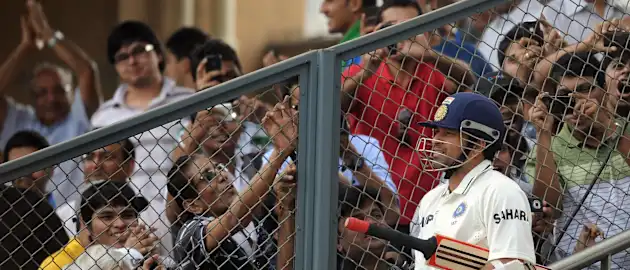
HALL OF FAME
In 2019, Tendulkar was inducted into the ICC Hall of Famealongside Australia’s Cathryn Fitzpatrick and South Africa’s Allan Donald. He was the sixth Indian player to join the exclusive club.
“It is an honour to be inducted into the ICC Cricket Hall of Fame, which cherishes the contribution of cricketers over generations,” he said. “They have all contributed to the growth and popularity of the game and I am happy to have done my bit.
“On this occasion, I would like to thank all of those who were by my side over a long international career. My parents, brother Ajit and wife Anjali have been pillars of strength while I was lucky to have someone like coach Ramakant Achrekar as an early guide and mentor.
“I am also thankful to all my captains, fellow players and the BCCI and the MCA administrators over the years for their support and for making me enjoy the game so much and for so long. I thank the ICC for this appreciation of my cricket career and I am happy to note that cricket continues to grow with three popular formats.”
With a jaw-dropping 34,357 runs and 664 caps for India, he well and truly earned his spot.
